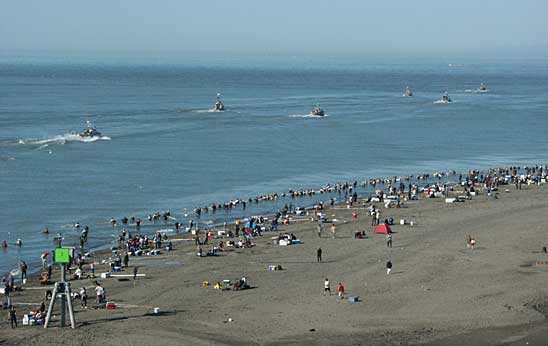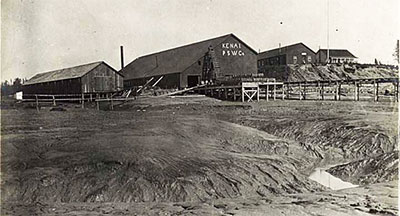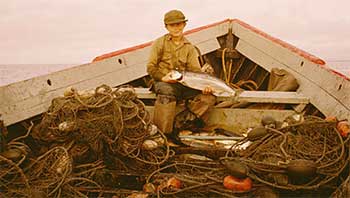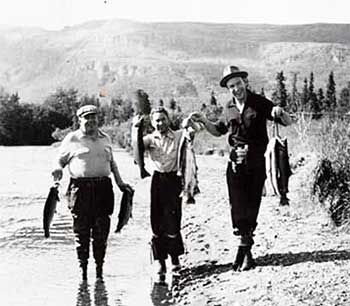Alaska Fish & Wildlife News
January 2014
The History of Upper Cook Inlet Salmon Fisheries
A Century of Salmon

The salmon-rich waters of Cook Inlet in Southcentral Alaska have given rise to several unique fisheries over the past century. The Kenai River boasts some of the most active fisheries in the state. Thousands of recreational fishers flock to the crowded banks every year with their rods, reels, and dip nets, ready to take home their limit of salmon. Alaska's recreational fisheries are a relatively new concept (the majority of the state’s historical fisheries being largely commercial) but have grown to become an integral part of the state’s income and fisheries management.
Many people who depend on salmon as a source of food also participate in the personal use fisheries. Personal use is described in the Alaska Department of Fish & Game’s Laws and Regulations as, “the taking, fishing for, or possession of finfish, shellfish, or other fishery resources, by Alaska residents for personal use and not for sale or barter, with gill or dip net, seine, fish wheel, long line, or other means defined by the Board of Fisheries [16.05.940 (26)].” Subsistence uses are defined as the "customary and traditional uses" of wild resources for food and other uses. Subsistence fishing is described by Fish & Game regulations as “the taking of, fishing for, or possession of fish, shellfish, or other fisheries resources by a resident ... for subsistence uses with gill net, seine, fish wheel, long line, or other means defined by the Board of Fisheries [Sec. 16.05.940 (31)]”.
The Early Days
One of the most important fisheries that helped shape the history of Alaska is the Cook Inlet commercial salmon fishery. The Kenai Peninsula has seen a tremendous history of canneries and buying stations since well before statehood. Since the late 1880s, commercial fishing has been a critical part of Alaskan economy and culture. Settlers rushed to build fish camps throughout the Kenai Peninsula because of abundant salmon resources and other finfish found there. Salmon packers built canneries at Kenai, Kasilof, Chisik Island, Homer, and near Tyonek. Giant fish traps were constructed and dropped into the ocean to harvest salmon by the thousands. For decades, commercial fishing thrived in Cook Inlet. But that was not to last.
In the early 1940s, the United States engaged in World War II. The government rationed certain food items, limiting available protein for not only the troops overseas, but citizens at home as well. However, the U.S. was in possession of a territory north of Canada, a territory that the U.S. Fish and Wildlife Service reported as being abundant with fish. And just like that, commercial fishing in Cook Inlet boomed. Thousands of fish were hauled in by drift-net and fish traps, sent off to the canneries, packed and shipped down to the Lower 48. It was a prosperous time for the salmon industry in the Last Frontier, but the negative effects that over harvest would have on the salmon runs could not be foreseen at that time. By the late 1940s, the fishery had begun to steadily decline.
One of the major contributors of salmon over-harvest in Cook Inlet during the 1940s was the fish trap. Fish traps were large machines constructed from wood piling and steel wire fencing. They were driven into the sea floor or suspended from floating frames anchored along the coast right in the salmon migration path. Described as “giant octopuses that grasps everything in its tentacles,” fish traps were responsible for bringing in thousands of salmon to Cook Inlet canneries each year. They were one of the most efficient and effective ways to harvest salmon, but combined with poor federal management, they were a little too effective. In fact, the traps were responsible for catching so many fish, that by the late 1940s, they had decimated most of the salmon runs. By the time fish traps were outlawed in the late 1950s, the damage was done. But overharvesting continued.
Combined with fish traps in Cook Inlet and other areas, poor management by the Federal Government, and the foreign fleet fishing just off shore, salmon runs plummeted statewide, and by the late 1950s were considered a federal disaster. The people of Alaska had been talking about statehood for a while but poor fisheries management is what finally sent them over the edge. An increasingly pitched political battle raged for 50 years between residents and nonresidents, between labor and capital, and between local fishermen and distant federal bureaucrats. Alaskans wanted the ability to manage their fisheries themselves and set restrictions and limits based on the data collected by people who knew the area best. When Alaska became a state in 1959, the federal government handed over fisheries management to the new state government, and the Alaska Department of Fish & Game was founded.
Statehood
The plan to restore the salmon runs in Cook Inlet and other areas of the state was simple. The first step was to fill river systems to the brim with spawning salmon. The best way to increase the number of fish seemed to be to stop killing them. Andy Anderson, the Department’s first commissioner, was quoted as saying to his biologists, “Gentlemen, the governor has instructed me to return the salmon runs to their former abundance regardless of the pain that is inflicted on the people. I’m charging each one of you to make sure every stream in your district is filled to the maximum spawning capability. Now, if you allow an over-escapement, depriving the fishermen of their livelihood, you can expect to be criticized. But on a personal level, gentlemen, I want you to understand that if you allow an under-escapement, you can expect to be fired.” The importance of 'maximum salmon spawning capability' was highly emphasized in Cook Inlet. In fact, through the majority of the 1960s, commercial fishermen were allowed to fish only a few days out of the entire summer. But the plan was working. Allowing for increased numbers of fish to reach spawning grounds began to gradually increase the salmon runs. But there was still more work to do.

One of the reasons that excessive harvests in Cook Inlet were allowed to continue for so long was because of inaccurate fish counts done by the federal government. Before statehood, the U.S. Bureau of Fisheries allowed fishermen to harvest half of the salmon run and let the other half escape to the spawning grounds. But there were no official run size numbers, fisheries enforcement, or data collected, and the fishermen sure weren’t counting. So when the Alaska Department of Fish and Game took control of Alaska's fisheries, they wanted to do it right. Biologists began collecting data of salmon abundance and harvest rates, setting up test fisheries, counting weirs, fish wheels, and flying aerial surveys to assess the size and strength of each run. These new methods of collecting information allowed local area management biologists to more accurately decide when to open and close commercial fishing around the state in order to ensure sustainable salmon runs.
It took nearly three decades of strict regulation and management, but in 1980, a record return of salmon surged back into Alaskan waters. The management plan set forth by Andy Anderson 20 years before had paid off and the commercial fishery in Cook Inlet was the strongest it had been in 40 years. The 1980s represented the triumph of Alaskan management for commercial fisheries.
Sustainability
The fish were back, and now the main concern was to not let them disappear again. This goal was accomplished through a policy of sustainable yield as directed by the state’s constitution. Sustainable yield is the concept of allowing harvest of surplus fish that are excess to the numbers of fish needed for maintaining a healthy, sustainable population. Salmon in Cook Inlet are managed to achieve long-term sustainability so that salmon runs stay both abundant and renewable for future generations.
In territorial days, fishing regulations were largely made in closed door meetings between federal regulators and the salmon packers. Alaskans had little, if any, say in what was decided. To provide for an open public process and to give direction to ADF&G, in 1949 the Territorial Alaska State Legislature created the Alaska Board of Fisheries (BOF). In its early days the Fish board was only advisory but with statehood the board was vested with the power to set regulations. Today the BOF is responsible for developing fishery management plans, allocating resources among users, and promulgating regulations. ADF&G, which supports and takes direction from the BOF, has unique Emergency Order authority that provides fishery managers with the essential ability to expeditiously open and close fisheries inseason.
There are several methods managers use to ensure that salmon populations in Cook Inlet are plentiful enough to support its fisheries, the most critical of which are escapement goals. To make sure that an adequate number of salmon spawn to produce a new generation of fish, a set number are allowed to escape capture before reaching their spawning grounds. It takes fish to make fish. By allowing sizeable populations of fish to reproduce each year, Cook Inlet fisheries can remain sustainable.
Another historic method that helped to ensure plentiful future salmon runs came with the commercial fisheries limited entry program in 1974. As salmon runs bottomed out in the 1950s and 1960s, the number of fishermen was on the rise. The trend accelerated after statehood when the elimination of fish traps required more fishermen. But with the introduction of limited entry, only a set number of commercial fishing permits were issued and commercial catch could be more closely regulated, allowing for escapement goals to be met and salmon populations to grow.
But there are two sides to sustainable yield. It’s certainly bad to let a salmon population dwindle in size, but allowing it to become too large can also be a problem. If too many salmon crowd the spawning grounds, fertilized eggs can be disturbed and released from their nest in the gravel and they will soon die or be eaten. Lakes and streams can also become so crowded with spawning fish that they die from competition for spawning areas or stress before they even get the chance to reproduce. And then there can also be intense competition among juveniles for precious food and habitat resources. In order to avoid this, numbers of spawning salmon are controlled by closely monitoring harvest and escapement levels for each river system while managing for escapement goals at the same time. Achieving escapement goals is the number one priority of ADF&G salmon managers.

Commercial fishing provides a powerful tool for keeping salmon escapements within the escapement goal range while allowing the harvest of surplus fish. This is also one of the main reasons why commercial fishing in Cook Inlet is so important. Sport, subsistence, and personal use fishermen all harvest thousands of fish from Cook Inlet each year, but the commercial fishermen are responsible for the majority of the overall catch (specifically sockeye, pink and chum). When escapements are within the goal ranges, emergency orders are issued to allow the commercial fleet to harvest excess fish. Without the valuable tool commercial fishing provides, escapement goals would often be extremely difficult for ADF&G management biologists to achieve.
Kenai Fish Wars
Although commercial fisheries and salmon processing dominated the Kenai Peninsula economy for much of the 20th century, the beginning of the “fish wars” was just on the horizon. In the early 1900s a newly built railroad set the stage for the first sport fishery on the Kenai Peninsula. It began with fishermen from Seward traveling to Kenai Lake and Cooper Landing to fish for large rainbow trout. As word spread about the exceptional size of these fish, sportsmen from the Lower 48 and around the world began traveling to Seward and lodges on Kenai Lake and so began trophy fishing and guide services on the Kenai Peninsula.
The local economy and population of the Kenai Peninsula continued to grow, and so did the non-commercial salmon fisheries. The Sterling Highway connecting Kenai and other Peninsula communities to Anchorage and each other was completed in 1951. Sport fishing slowly developed into a major recreation on the Kenai Peninsula and has rapidly increased since the 1970s when techniques for catching king salmon were refined with use of colored lures and scent. By the early 1980s the sport fishery was becoming a major competitor with commercial and subsistence salmon fisheries and exploded when the world record king salmon, 97 pounds, 4 ounces, was sport caught in 1985 on the Kenai River. Today the Kenai Peninsula provides the majority of the total annual sport fishing effort in the state making the Kenai River the most heavily fished river in all of Alaska.
As the Kenai Peninsula area and its fisheries continued expanding, so did the regulations and legal battles. Over the past two decades subsistence and personal use fishing in Cook Inlet have undergone numerous court cases and regulatory changes reflecting the efforts by the state and federal governments and the court system to develop a legal definition of subsistence use. Personal use and subsistence fisheries had coexisted together since 1981. Then in 1996, most of Cook Inlet was closed to subsistence harvest of salmon and the current personal use fisheries were adopted by the BOF, and thus the modern day Kenai River dipnet fishery was born. In lieu of subsistence fisheries, four popular personal use fisheries were put into regulation and opened to all Alaska residents: Fish Creek dip net, Kasilof River set gillnet, Kasilof River dip net, and Kenai River dip net. These fisheries specifically target sockeye salmon, although Chinook, coho, pink and chum salmon, and other fish are also harvested. As the popularity of the Upper Cook Inlet personal use fisheries grew the BOF put a permit requirement into regulation so that the number of fish harvested could be estimated. Today all participants are required to get a free permit or be a member of a household with a permit. These fisheries are open to Alaska residents only.
Currently two personal use fisheries occur in the Kasilof River. These are the set gillnet and the dipnet fisheries. Inseason management of the set gillnet fishery is managed by the Alaska Department of Fish and Game, Division of Commercial Fisheries who also operates a sonar counter on the Kasilof River to monitor escapement. From 1996 through 2001 the Kasilof River area set gillnet fishery was opened and closed by emergency order based on a target harvest range. In 2002, the BOF changed the management plan so that the set gillnet fishery opens and closes by regulation, therefore inseason management action is required only if ADF&G projects the minimum sockeye or king salmon spawning escapement goals will not be met. Inseason management of the dipnet fishery is the responsibility of the Alaska Department of Fish and Game, Division of Sport Fish. The dipnet fishery also opens and closes by regulation, and inseason management action is required if the escapement goals are projected to not be achieved or if the escapement goals are exceeded.

Inseason management of the Kenai River dipnet fishery is also the responsibility of the Division of Sport Fish. The fishery opens and closes by regulation, and inseason management is required if it is projected that the inriver escapement goal (as assessed by the sonar at river mile 19) for sockeye salmon will not be met or if the escapement goals are exceeded.
Growing Popularity
Over the last decade more Upper Cook Inlet personal use permits have been issued each year than before indicating that these fisheries are continuing to increase in popularity. The majority of participants fish the Kenai dipnet fishery which has grown since 1996 with few exceptions. Approximately 15,000 permits were issued in 1996 and by 2012 the number of permits issued exceeded 34,000. More than 35,000 Upper Cook Inlet personal use dipnet permits were issued in 2013. This growth has also led to increased effort and harvest estimates in all Cook Inlet personal use fisheries.
In short, there is a long, long history of harvests and use of salmon in Cook Inlet. A history that pre dates the Euro-American colonization of Alaska and continued through the Russian, territorial and statehood periods. The Kenai Peninsula has undergone pronounced and rapid demographic growth and socioeconomic change over the last 100 years. With this radical change came increased pressure on Cook Inlet’s fishery resources that many Southcentral Alaskans rely on today. Highways, roads and rail were built which significantly influenced participation and harvest levels and made easy access to the rich and bountiful fishing areas of Cook Inlet. Without a doubt the challenges facing the unique fisheries of Cook Inlet over the next 100 years will require the continued commitment, research and investment by ADF&G that allowed Alaska fisheries to rebuild and prosper since the early days of statehood. Fortunately, Alaska’s fisheries have been built on a firm foundation: a constitutional mandate for sustained yield, a commitment to scientific research, and to serve the Alaska people.
Cook Inlet, like all of Alaska’s salmon resources, must be managed to ensure that stocks are harvested at sustainable levels for the enjoyment and benefit of all users, both present and future generations. Although commercial fishing is a major industry in Cook Inlet, and has been for hundreds of years, it is also an important management tool that brings stability to the cyclic highs and lows of wild salmon populations. As Alaskans we love our salmon and in the end all users benefit equally and enjoy one of the world’s most abundant sources of wild seafood. Alaska’s economy, culture, and identity have been and will continue to be shaped by salmon, not just because of its importance or size, but because our history is in our fishery.
Further Reading:
Brannian L. and J. Fox. 1996. Upper Cook Inlet Subsistence and Personal Use Fisheries, Report to the Alaska Board of Fisheries, 1996. Alaska Department of Fish and Game, Division of Commercial Fisheries, Regional Information Report 2A96-03, Anchorage.
Clark, R., M. Willette, S. Fleischman, and D. Eggers. 2007. Biological and fishery-related aspects of overescapement in Alaskan sockeye salmon Oncorhynchus nerka. Alaska Department of Fish and Game, Special Publication No. 07-17, Anchorage.
Dunker, K. J. 2010. Upper Cook Inlet personal use salmon fisheries, 2007-2009. Alaska Department of Fish and Game, Fishery Data Series No. 10-89, Anchorage.
Fall, J. A., R. T. Stanek, B. Davis, L. Williams, and R. Walker. 2004. Cook Inlet customary and traditional subsistence fisheries assessment. Alaska Department of Fish and Game, Division of Subsistence, Technical Paper No. 285, Anchorage.
King, Bob. Sustaining Alaska’s Fisheries: Fifty Years of Statehood. Alaska Department of Fish and Game: Juneau, 2009.
Woodby, D., D. Carlile, S. Siddeek, F. Funk, J. H. Clark, and L. Hulbert. 2005. Commercial Fisheries of Alaska. Alaska Department of Fish and Game, Special Publication No. 05-09, Anchorage.
Katie Sechrist and Joe Rutz work with the Division of Commercial Fisheries at The Alaska Department of Fish and Game.
Subscribe to be notified about new issues
Receive a monthly notice about new issues and articles.
